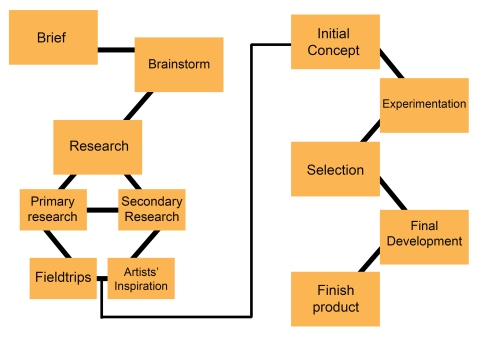The design workflow is a process which you must ensure you go through before starting a project. This is the best way to think outside the box and give more than what the brief is asking you to do. Another reason behind carrying out the design workflow is to have a better understanding of the task, as the more knowledge you have the better your final outcome will be.
I will now talk about the design working method which I have been referring back to whilst working on my project. The project brief was to produce a digital magazine as a group about anything relating to Birmingham. We chose to look at something different and look at homelessness in the city, as this seemed to be quite an awakening issue.
The design workflow chart I referred back to was the diagram below.

I chose this one as I thought it's clear, straight forward and very easy to follow. The simple structure allows you to work step by step and not get confused as to what you are doing. I think it has a very good flow to it and helps you widely during the time of working through your RVJ's. Staring from the main point which is the brief, allows you to think and brainstorm anything and everything in relation to your project. I followed this method and done a brainstorm of Birmingham, we did this to let ourselves lose and think about anything which could be an interesting part of the city.
By doing this we gathered a lot of ideas and put them all together to agree on one final idea, which we would base out magazine on. We first agreed on looking at the distinction between day and night life in Birmingham and how peoples lives change during the day and night. However we then decided that this was not a strong subject to base our magazine on; as we asked ourselves question like- would you read the magazine? would you pay to buy this magazine? what do we find interesting about the magazine? As we weren't too keen on the subject area we were looking at, we then decided to change it to something unique and started to gather primary and secondary research on the homeless people in Birmingham.
For primary research some of the group members went out to interview homeless people at the homeless shelters and banks and also people who sell the Big Issue in the town centre. Whereas for secondary research we looked at artists and other visual communicators who's work we though linked in to ours. For example Lee Jefferies photographs have great emphasis on the homeless, as he takes close up shots of just their faces; through which you can see every little detail. I thought this was very unique and added some photographs into my own research. Gradually we go towards producing examples and rough sketches of what our final outcome will be about and get finalizing the selection stages. All in all i thought that this was a very simple design workflow to follow and helped and guided me alot during the whole project.
The Novice to Expert
The novice to expert is a diagram which shows you what you need in order to become an expert. The diagram was shown to us in our lecture. Looking at the scale, I personally think I am still at the beginners level as I am still new to Graphic Design, however I know I will progress as I have a great interest in the area and am willing to do well and improve my current skills. I believe that university has made me become a more independent and reliable person; as I always find myself working towards deadlines and working to the best of my ability at all times, because I am motivated and dedicated to do so. As I am only just in my first year, I believe that I still have alot of progress to make throughout the years and improve vastly. I think there is so much more which I can give and take in at the same time and I am still gaining more and more knowledge each day towards becoming a successful Graphic Designer.
No comments:
Post a Comment